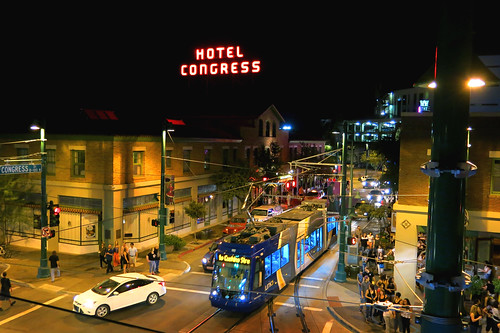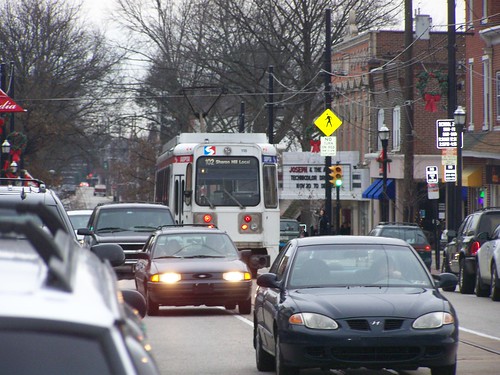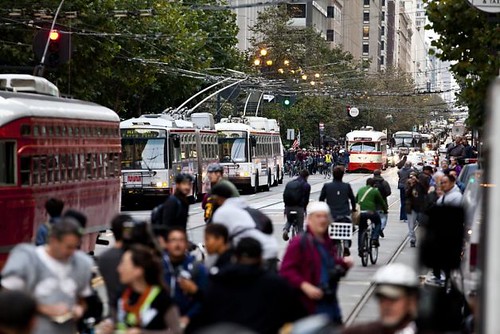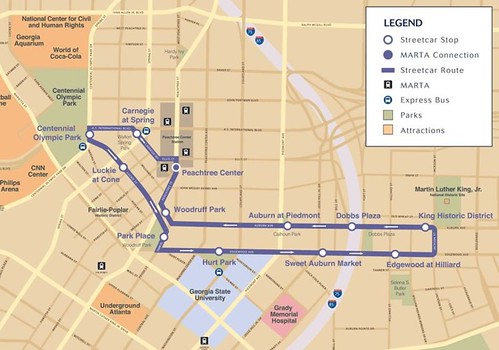The argument that streetcars are "good enough" but "imperfect transit" is flawed
While they use what we would call light rail vehicles, the tram in Bilbao functions more comparably to how streetcars are deployed in the United States. Image from Simplon.
David Alpert of Greater Greater Washington is now writing for CityLab, where he has a piece "Hey, Streetcar Critics: Stop Making 'Perfect' the Enemy of 'Good': Even when they're not ideal, streetcar projects can still benefit cities. Here are five ways how," that argues that yes, based on the arguments of people like Matthew Yglesias and transit consultant Jarrett Walker streetcars are imperfect when they don't have a dedicated right of way (nn a slightly different context, I cited those pieces, "Transit stuff #3: bus rapid transit vs. the creation of foundational suburban mass transit systems") but that's okay because they are a good start.
David's arguments are:
- Imperfect transit can still be good for cities.
- An imperfect streetcar might be all your city can afford—for now.
- Funding won't get redirected towards a "better" transit project.
- Streetcars can outperform buses, even without dedicated lanes.
- Your city can make it better later, and may even plan to.

Such arguments are beside the point because streetcars are about intra-city transit service not inter-city transit service.
In short, streetcars enable access, while light rail and heavy rail are focused on enabling speedy trips between comparatively distant locations.
The "imperfect transit is okay" trope is flawed and doesn't push the argument forward in a solid way. The writings by Yglesias, Walker et al. are similarly flawed because they judge streetcars against criteria not fully appropriate for streetcars or attribute benefits to bus service that haven't been demonstrated to be true.
Failure to plan transportation at the metropolitan, suburban and center city scales is a problem. I'll start by pointing out that there is a real problem in "epistemology" in transportation planning because we don't have much of a systematic approach to planning transit at the metropolitan, regional and larger scales.
Plus, most people writing about transportation don't employ a systems approach to the subject.
I offer such a framework (presentation, "Metropolitan Mass Transit Planning: Towards a Hierarchical and Conceptual Framework;" general discussion, "Without the right transportation planning framework, metropolitan areas are screwed, and that includes the DC area") based on the analysis of such failures to plan adequately in the Washington-Baltimore region (in my model a region is defined as two or more metropolitan areas).
Note that when you talk to people who know transportation, the consensus is that the DC area's "Metropolitan Planning Organization," which is tasked by the Federal Government to do metropolitan transportation planning, is one of the least innovative MPOs across the nation's major cities.

Streetcars are intra-city transit and should be judged on that basis. The point of streetcars isn't to provide fast trips between cities over long distances, it's to service shorter trips within cities, and more narrowly, within sub-districts of cities, as part of what I call intra-city and intra-district transit ("Making the case for intra-city vs. inter-city transit planning").
 Another way to think about it is that streetcars complement inter-city transit.
Another way to think about it is that streetcars complement inter-city transit.Sreetcars aren't the only way to provide such services, bus circulators are too in theory (and in what I call "tertiary" transit subnetworks, of which Tempe Arizona's Orbit system is the best example), although for a variety of reasons, compared to buses streetcars are more likely to spur additional economic development.
Streetcars are devices for repositioning communities. As importantly, today's streetcar deployments are designed to foster sustainable transportation modes of all types, with the end game of reducing automobile use, while simultaneously fostering economic revitalization.
In the context of the metropolitan landscape (a/k/a "the suburbs"),* streetcar systems are key elements in the process of re-branding cities, districts and neighborhoods as places worth living, working, and playing in as well as visiting.
Streetcars reposition the attractiveness of center city residential and commercial districts making these places attractive, and shifting locational choices and business back to the center city.

Night time view, new streetcar system in Tucson. Flickr photo by Chris Conforti.
The deployment of streetcars in Portland and Seattle and more recently Tucson are the best examples of this in practice.
Salt Lake City's creation of a streetcar service in the Sugar House district--the system launched in December 2013--is another example of streetcar service as both an economic development and mobility access strategy focused on auguring revitalization in a part of the city that has experienced decline over the past few decades ("New apartments, development poised to reshape Sugar House," Salt Lake Deseret News).
And Atlanta is about to join this group, as their streetcar service is in testing now and will begin revenue service later in the year ("Atlanta Streetcar enters new testing phase," Atlanta Journal-Constitution)
I wrote about the economic development argument here, "STREETCARS ARE ABOUT TRANSIT, just in a different way from how most people are accustomed to thinking about it."
On that basis, "imperfect transit" isn't the issue, what matters is the facilitation of the ability to get around, preferably not by automobile, in places where work, school, and other activity centers are close to home, and the greater likelihood of choosing such locations as a place to live or work or locate commerce vis-a-vis other locations across the metropoolitan landscape.
 Flickr photo by Paul Bingman of a Portland streetcar arriving at NW 23rd & Marshall Streets in the Nob Hill neighborhood.
Flickr photo by Paul Bingman of a Portland streetcar arriving at NW 23rd & Marshall Streets in the Nob Hill neighborhood.Portland Streetcar no. 007 inbound at SW 5th/Montgomery. Photo by Peter Ehrlich, September 2009.
Frankly, I can't believe that anyone who has ever seen how the transit system works in Portland could doubt the potential and effectiveness of streetcars.
While the Pearl District is a national example of urban revitalization facilitated by streetcar service, the increased success of Nob Hill as a neighborhood served by the streetcar with a thriving commercial district (with multiple independent cinemas) is unheralded, but no less important as an example of the streetcar's success.
Note that Little Rock-North Little Rock, Arkansas and their use of historic streetcars as a revitalization tool has been similarly successful. See "CAT: Making More with Less" from Mass Transit Magazine. Photo above from Rail Preservation.
Bilbao is another good example, especially in how the trams have a different purpose than the subway system..
The streetcar's place in the development of cities and urban form is nothing new. And as I've said before, it's not like streetcars are new to the city and close-in suburbs. And in cities like Philadelphia, Toronto, and Boston, streetcar service never entirely went away. San Francisco too, although its surface transit system--separate from the Market Street Railway heritage streetcar operation--is considered to be light rail.
.
In this area, Chevy Chase in both DC and Maryland is the oft touted example, but frankly even H Street NE "was opened up to development" by the construction of a horse car trolley system, created by landowners like Henry Willard, after they had difficulty selling residential lots where there was no transit service and the location was perceived to be distant from the city center.
Another classic example is Shaker Heights and Cleveland Heights by the Van Swearingen Brothers, who bought a railroad to get access to the right of way they needed for a streetcar system.
But there are hundreds and hundreds of examples in cities across the country.
Portland between Downtown, the abutting "Pearl District" and Nob Hill is only the most prominent, modern, interpretation of this approach.
More recently, Seattle (pictured at left) adopted streetcar service to accelerate repositioning and revitalization of the SoDo district--the system launched in 2007 and is being expanded with service to Capitol Hill, among other places, although service has been delayed because of manufacturing delays.
Note that with streetcar service, Amazon moved their headquarters to Seattle, from its original suburban location in Bellevue.
DC's streetcar planning failures shouldn't be held against streetcars as a mode and system. A lot of the discussion about streetcars being imperfect but that's okay has resulted from problems with DC's development of a streetcar program.
The first attempt, in Anacostia, seems to have failed over right of way and community opposition issues. On H Street NE, the program has taken a long time to deploy, because of certain failures in planning. Plus you could argue that H Street "doesn't need" a streetcar to foster revitalization, although I would argue that the development of streetcar service has accelerated revitalization and will facilitate the district again becoming a major retail center.
On the other hand, the H Street line is "imperfect" because of planning failures, and years ago I argued ("Will streetcars really return to the Capital City?") that it would be better to start streetcar service in a part of the city with inadequate transit service, like between Woodley Park and Brookland, with service to the Washington Hospital Center, where the benefits would be readily apparent.
But that's not what happened.
This editorial cartoon from Tucson's Arizona Daily Star highlights the $600 million in new development along the streetcar route, development that might have otherwise located in suburban locations.
Again, Portland, Seattle, Tucson--where the commitment to build the system was initiated by citizen activism not developers--and probably Atlanta provide better examples of how to plan, build, and benefit from streetcar service.
Academic resources. In 2010, University of British Columbia's Patrick Condon authored a book, Seven Rules for Sustainable Communities, touting the historic streetcar city model. "Why a Streetcar Is Something to Be Desired: Rule 1 for sustainable communities: Restore the streetcar city," from The Tyee, Vancouver's alternative weekly, highlights that element of the book.
 Streetcar in Media, Pennsylvania, a suburb of Philadelphia.
Streetcar in Media, Pennsylvania, a suburb of Philadelphia.Of course, there are many good histories about streetcar suburbs and the development process, such as books by Sam Bass Warner.
Geographer Peter Muller's journal article on transportation and urban form is also very good ("Transportation and Urban Form: Stages in the Evolution of the American Metropolis").
For urban design elements, the out-of-print DC Office of Planning publication, Trans-Formation: Recreating Transit-Oriented Neighborhood Centers in DC: Design Handbook, covers the application of those historic urban design principles to today's neighborhoods.
----------
[* Interestingly, in the Washington metropolitan area, the prime motivation for creating the Silver Line in Fairfax and Loudoun Counties isn't to provide service to the Dulles International Airport, it's to provide those counties with a way to compete with the core of the metro by also providing high quality transit service. See "Short term vs. long term thinking: transit, the Washington Examiner, Fairfax/Loudoun Counties vs. DC."]

Modern light rail/streetcar service in San Francisco. Flickr photo by CurleyR.

Heritage streetcar service in San Francisco. Photo: Jason Henry, San Francisco Chronicle. San Francisco's electric trolley buses also service Market Street and are visible in this photo.

The route for the Atlanta Streetcar demonstrates a kind of directness and purpose not fully evident from the upcoming deployment in Washington, DC's H Street NE neighborhood.
Labels: fixed rail transit service, neighborhood revitalization, transit and economic development, transportation planning, urban design/placemaking, urban revitalization



.jpg)





17 Comments:
DC already has excellent dedicated streetcar rights of way in places like Pa Avenue & off of Reservoir Road which the planners have ignored in order to reinvent the wheel so it seems.
FWIW, the old #20 route (Glen Echo) doesn't illustrate my thesis...
maybe so- but my point is that many of the criticisms are directed at streetcars in the USA because they do not have dedicated lines and mix them with traffic- it does not mean that we NEVER had this in fact we DID have this- and we can again but for the stubborness of our planners who want to reinvent everything- I say- put the streetcar lines in DC back exactly where they once existed as they have done in Philly with Girard Street. In some cases the tracks still exist and are just under the surface- of course all new tracks need to go in but why not make it truly a historic revival- and this way get the reluctant and hypocritical historic preservationists [ who seem to hate streetcars] to jump abord with historic branding but new cars and tracks- just old routes? Planners- it seems - far o too often get bogged down in legalism and regulations and sacrifice imagination and excitment. Make no small plans for they do not stir men's blood !! [ Peoples' blood]
Note that with streetcar service, Amazon moved their headquarters to Seattle, from its original suburban location in Bellevue.
The previous Amazon headquarters was located on Beacon Hill in Seattle, not in Bellevue. I'm being pedantic, but they moved out of the Pacific Building because they were growing too large.
Again, Portland, Seattle, Tucson--where the commitment to build the system was initiated by citizen activism not developers--and probably Atlanta provide better examples of how to plan, build, and benefit from streetcar service.
I disagree with Seattle (South Lake Union) streetcar being driven by citizen activism. It was driven by Vulcan and other local property owners in the area. I lived there when this was being debated and built, and this was not viewed as a popular proposal.
I was one of those people at the time, although I will certainly admit that it has been successful for the South Lake Union Area.
maybe it's not clear (note the emdashes specifically on the Tucson mention), but I was referring specifically to Tucson in terms of citizenn activism.
There is no question that the driving force behind the streetcar in Seattle was Paul Allen/Vulcan.
I guess I should change the mention about Amazon. Were there other suburban operations that got consolidated there too, or was everything just moving from one part of the city to another?
the picture of little Rock's streetcar looks fantastic !!
To clarify further: I understand that your definition of success lies entirely in redevelopment and not an all in anyone's ability to get where they're going in the larger city.
But no number of studies about redevelopment around the streetcar will ever establish causation. The Pearl District and the Streetcar were all the same project, driven by the same people, and we'll never know what would have happened if a really nice and frequent bus line were where the streetcar is now.
To establish a causal claim, you should really take everything that's happened along the streetcar and subtract the value of everything that's happened on bus lines in Portland in the same period. That would bring you closer to a causation argument.
I'm not gonna argue with you as reasonable people disagree. But I think my points about intra-district access and mobility are reasonable. The Portland streetcar is a good example of the concept, but it's hardly the only one. The Charm City Circulator in Baltimore is another. Arguably, Tempe's Orbit system qualifies too, and the other streetcar projects I mentioned.
2. WRT the economic and transit element the problem is that no place can ever be a perfect "study" because of the existence of multiple modes.
So in DC just as in Portland with the streetcar, because of the existence of heavy rail perhaps you'll never get people to willingly embrace buses, the way that you say there is a problem in Portland.
HOWEVER, as you know, the Downtown Plan of 1972 prioritized bus service and the transit mall, before there was any planning for or development of light rail.
How did buses do then? Not snark, a question. My only experience with Portland has been post-LR, post-streetcar.
Similarly, visiting DC as a tourist in 1974, I was transfixed by all the buses moving to and fro on Pennsylvania Avenue and elsewhere in Downtown. I don't know how they did with ridership by then, but undoubtedly had higher ridership before automobile ownership became more prevalent.
3. and about causality, in my other writings, I am the first to say it's very difficult to suss out and attribute all of the affects of development around transit to transit investment specifically.
As you know, it's not really possible to do a pure study of the phenomenon.
(My biggest example of the problem is attributing all of the development in Cleveland's university area to the BRT, when those institutions grow inexorably anyway.)
4. because of the small scale of Portland's downtown and the proximity of the Pearl District to both Downtown and Nob Hill, it's reasonable to assert that much of the development in the Pearl District could have occurred without a streetcar, without dedicated transit at all.
Similarly, with H Street being proximate to both Union Station and NoMA Metrorail stations--although they are located perpindicular to H Street--development would have moved that way anyway, just as I argue that development in Downtown would have moved east as the western section was built out, whether or not Verizon Center was built.
Still, there is no question that Verizon Center helped accelerate the change, even if it might have happened anyway.
5. Tough questions.
buses suck- they are moud dirty and they look crappy. I for one- despite my misgivings about piss poor planning of the new streetcar network in DC- wholeheartedly support it because it is a good start and we need to start somewhere- and people need to stop bucking this good trend because I did not know of anyone pissing and moaning when they took out our streetcars in DC. I suspect it is mostly older people like in the CHRS and Cmte 100 that complain the most but I am now aware of some young people that should get over to Germany and see what they have done in great cities like Potsdam and Berlin with their streetcars- and in numerous other cities as well. We should be emulating their successes and not just think about cars and how cars should be getting around. This is th eway to go. certainly we could rebuild the Pallisades streetcar as it once was - and it was lovely- I recall the whole right of way from not too long after it was halted- and we can do it better- but H street is going to work and its going to be EXCELLENT !!!
Excellently reasoned article. What Richard captures here, and Jarrett misses (we argued all last weekend at City Lab about this) is quite simple: streetcars, mixed traffic or not, facilitate a creation of place. We can't judge every modal choice and the sharing of right of way based on the backdrop of "the car is king" which is what happens when we look at mixed-traffic running-rail.
I also think it's important to look at the neighborhood to neighborhood connections we lost and will regain with the perceived reliability of streetcar service. 3rd, we overestimate the importance to humans of speed vs. reliability and comfort on these intra-city trips.
Catalyzing a new/old sense of place is something that very few other modes can do. In terms of neighborhood connectivity, I argue that bikeshare has been the most significant contribution in this area and has helped fill a gap left by the streetcar. Now let's add the streetcar layer back, and with the DBOM that DC will use, the system can be designed and built efficiently vs. the piecemeal planning deficient approach that Richard cites.
Thank you for commenting!
You make an interesting point about bikeshare. The thing about bikeshare is that it is more personal transportation than mass transit, but there is no question that it has the same impact on cementing "the value of place" and encouraging sustainable transportation trips as opposed to car trips.
In my "mobility shed" model, which needs to be updated with some "new" modes, bike share needs to be emphasized more than it already is to reflect your point.
http://urbanplacesandspaces.blogspot.com/2008/09/updating-mobilityshed-mobility-shed.html
I didn't discuss the mobility shed piece in this one, but that concept provides more structure for thinking about place and the link with transportation infrastructure.
FWIW, separately I am working longer term on what I jokingly call "the unified theory" about transportation planning and placemaking in the context of the integrated public realm framework, e.g., as discussed here:
http://urbanplacesandspaces.blogspot.com/2013/09/transit-stations-and-placemaking.html
it comes across to me as incredibly absurd and petty that in Georgetown great efforts are made to preserve a stretch of historic streetcar tracks and yet if a new streetcar were slated to go onto these same tracks the NIMBYs would up and roar with self righteous indignation and censure. These idiots want it only for their car and access to parking. Anything that remotely threatens a parking space is anathema and verbotten .
I didn't mention it when I was writing but when Philadelphia brought the streetcar back to Girard Avenue (I had a piece inspired by Girard Ave. in the Philadelphia Daily News in 2003), the opening was delayed by as much as a year because of opposition to the "loss" of parking spaces at the turnaround.
Eventually, they conceded. I don't know how the streetcar is doing now, I'm sure fine.
I think about streetcars though every time I drive on Germantown Ave. because the tracks are still there...
thing is- in Philly the tracks are mostly in good shape. In Dc we let them deteriorate. As for a real heriatge and tourist draw to popularize streetcars I still think the Resevoir Road- Glen echo line to be redone . It would attract a alot of interest IMO. The NIMBYs- of course- would hem and haw about it. And watch as the super liberal elite secretly talk among themselves about how it will bring black youth crime into their pristine Spring Valley region...which was one of the big reasons that line was allwoed to fall when it did. Hypocrites all around . I rode the Girard street line back in 2006- it was fantastic.
Hmm, I see your point about Glen Echo now.
... ideally you could start sort of how SF did, in bringing back the heritage streetcars. Just run it on weekends, using the vehicles from the Trolley Museum. (We went there, briefly, a few months ago, and we got to ride in the Blackpool "boat" open air car.)
http://www.amazon.com/San-Franciscos-F-Line-successful-transportation/dp/1466937394
interesting factoid-from wiki- " In 1945 Capital Transit had America’s 3rd largest streetcar fleet"
It has been very useful, I was looking for something similar,
greetings and thanks.click it...: https://www.dosepharmacy.com
Post a Comment
<< Home